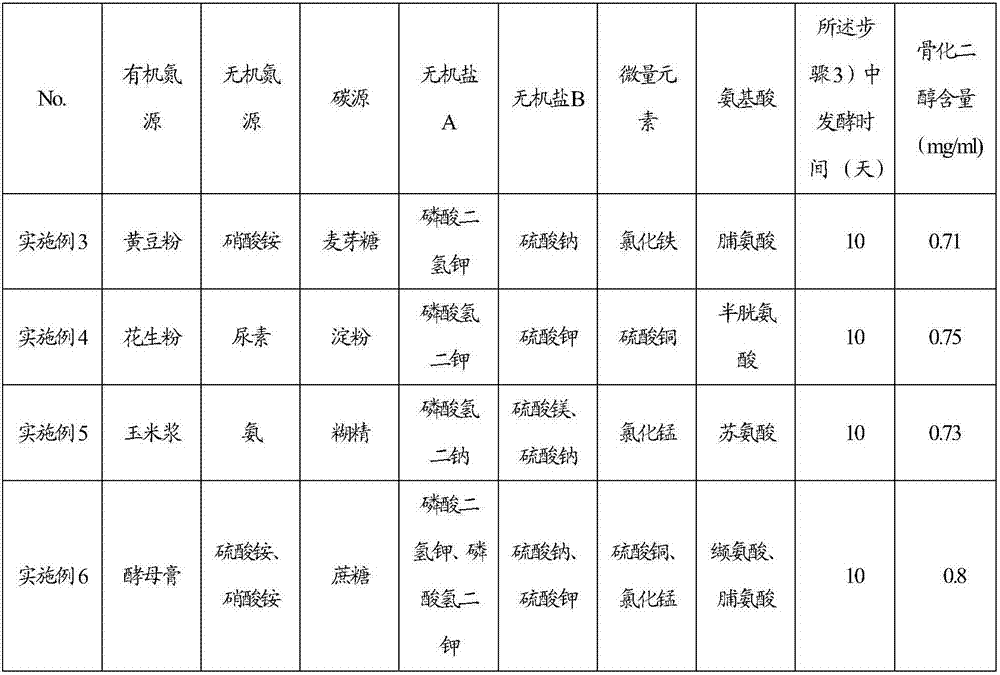Feeding culture medium by fermenting calcifediol, feeding method for fermentation and fermentation method of calcifediol
A technology of feeding medium and calcifediol, which is applied in the field of feeding medium for calcifediol fermentation, can solve the problem of slow growth of product calcifediol production, affecting enzyme activity in mycelium and pH value of fermentation broth. It can improve the oxygen transfer process, avoid volume reduction, and meet the needs of dissolved oxygen.
- Summary
- Abstract
- Description
- Claims
- Application Information
AI Technical Summary
Problems solved by technology
Method used
Image
Examples
Embodiment 1
[0071] 1)
[0072] A) Inclined bacteria:
[0073] The slant medium is composed of glucose 1.5g / l00ml, peptone 1.0g / l00ml, corn steep liquor 0.3g / l00ml, sodium chloride 0.4g / l00ml, agar 1.5g / l00ml and the rest of water; the pH value of the slant medium is 7.0 .
[0074] The bacterial strain with the preservation number CGMCC No.7935 was inoculated into the slant medium for culture to obtain the strain with the preservation number CGMCC No.7935.
[0075] B) Seed solution:
[0076] The seed medium consists of peptone 1.5g / l00ml, corn steep liquor 1.5g / l00ml, glucose 1.5g / l00ml, soybean powder 0.4g / l00ml, sodium chloride 0.5g / l00ml, potassium dihydrogen phosphate 0.2g / l00ml and the rest Water composition; the pH value of the seed medium is 7.5.
[0077] Inoculate the strain with the preservation number CGMCC No.7935 into 100ml of seed culture medium and 500ml Erlenmeyer flask, shake the flask at a speed of 280r / min, and culture at 29°C for 3 days to obtain a first-class seed l...
Embodiment 2
[0085] The difference between this embodiment and Example 1 is that the feed medium includes: organic nitrogen source 0.5g / l00ml, inorganic nitrogen source 0.2g / l00ml, carbon source 0.5g / l00ml, inorganic salt A0.2g / l00ml, Inorganic salt B 0.2g / l00ml, trace elements 0.0003g / l00ml; the organic nitrogen source is peptone, the inorganic nitrogen source is ammonium sulfate, the carbon source is glucose, and the inorganic salt A is sodium dihydrogen phosphate, The inorganic salt B is magnesium sulfate, and the trace elements are manganese chloride and ferric chloride.
[0086] Test results: the fermentation time in the step 3) was 10 days, and the HPLC analysis of the liquid obtained showed that the content of calcifediol was 0.75 g / ml.
Embodiment 3~7
[0088] The difference between this example and Example 1 is only that the organic nitrogen source, the inorganic nitrogen source, the carbon source, the inorganic salt A, the inorganic salt B, the trace element And the selection of the amino acid, the selection of the feed medium components and the test results: the fermentation time in the step 3) and the HPLC analysis of the calcifediol content of the feed liquid are shown in Table 1.
[0089] Table 1
[0090]
[0091]
[0092] From Examples 1 to 2, 3 to 7, it can be seen that in the feed medium, preferably, the organic nitrogen source is selected from one or more of peptone, soybean powder, peanut powder, corn steep liquor and yeast extract, and more preferably Preferably, the organic nitrogen source is peptone; preferably, the inorganic nitrogen source is selected from one or more of ammonium sulfate, ammonium nitrate, urea and ammonia, more preferably, the inorganic nitrogen source is sulfuric acid Ammonium; prefer...
PUM
 Login to View More
Login to View More Abstract
Description
Claims
Application Information
 Login to View More
Login to View More - R&D
- Intellectual Property
- Life Sciences
- Materials
- Tech Scout
- Unparalleled Data Quality
- Higher Quality Content
- 60% Fewer Hallucinations
Browse by: Latest US Patents, China's latest patents, Technical Efficacy Thesaurus, Application Domain, Technology Topic, Popular Technical Reports.
© 2025 PatSnap. All rights reserved.Legal|Privacy policy|Modern Slavery Act Transparency Statement|Sitemap|About US| Contact US: help@patsnap.com



